 Image search results - "tokyo" Image search results - "tokyo" |

Dai-hiwatari Festival, Mt. TakaoMore pictures here
|
|

My video of 2023 Koenji Awa Odori. 第64回高円寺阿波おどり
|
|

My video of 2018 Koenji Awa Odori 第62回高円寺阿波おどり
|
|

My video of 2017 Koenji Awa Odori (56 troupes) 第61回高円寺阿波おどり
|
|

My video of 2016 Koenji Awa Odori (56 troupes) 第60回高円寺阿波おどり 56連の総集編
|
|

My video of Koenji Awa Odori 2015 第59回高円寺阿波おどり 40連の総集編
|
|

My video of Koenji Awa Odori 2013 Part 1/3 第57回 東京高円寺阿波おどり 総集編
|
|

My video of Koenji Awa Odori 2013 Part 2/3 第57回 東京高円寺阿波おどり 総集編
|
|

My video of Koenji Awa Odori 2013 Part 3/3 第57回 東京高円寺阿波おどり 総集編
|
|

My video of Koenji Awa Odori 2011 Part 1/2 高円寺阿波おどり
|
|

My video of Koenji Awa Odori 2011 Part 2/2 高円寺阿波おどり
|
|

My video of Koenji Awa Odori 2009 Part 1/3 - Kokesaku 苔作
|
|

My video of Koenji Awa Odori 2009 Part 2/3 - Kikusui-ren 菊水会菊水連
|
|

My video of Koenji Awa Odori 2009 Part 3/3 - Asuka-ren 飛鳥連
|
|
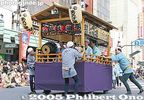
Sadly, the Tokyo Jidai Matsuri is no longer held. It was held annually on Nov. 3 (Culture Day) in Asakusa, Tokyo from 1988 to 2013.The festival was discontinued due to a money scandal by Taito Ward. Tokyo Jidai Matsuri (Festival of Historical Periods) was a parade tracing the history of Tokyo with over 1,600 people dressed in the respective period's costume. This is the lead float playing music. It took about an hour for the parade to reach Kaminarimon Gate.
Lead Float: Edo festival music played by children. Kodomo Edo-bayashi yatai
先導 子供江戸囃子屋台
|
|
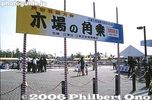
Kiba Park with Kiba Kakunori sign. Traditional folk performances are held on the same day as Koto Ward's Citizen's Festival in mid-Oct. So the park is quite crowded.
|
|

Haneda to Tokushima
|
|
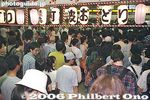
Crowd at JR Koenji Station on Awa Odori night.The Koenji Awa Odori is basically a parade of dancers. Many groups of dancers from various parts of Japan participate in the parade that follows the main shopping streets near Koenji Station on the Japan Railways Chuo Line in Tokyo.
|
|

April 8, 2006 at Ushigome-Tansu Kumin Hall in Kagurazaka, TokyoStarting at 4 pm, this was the third and last show of the day and all 400 seats were sold out.
The performance had two parts separated by a 20-min. intermission. Each part had several different dances.
|
|

Before 8 am: Women do a warm-up lap.It wasn't exactly warm, but they had wet suits. Odaiba's water is not exactly crystal-clear clean either.
|
|

Established in 1617, Tsukiji Hongwanji temple is the Tokyo headquarters of the Nishi Hongwanji Jodo Shinshu sect. The present temple, based on Indian architecture, was built in the 1930s.The temple is the only one in Japan which is under the direct control of the sect. Its head priest is the Monshu Abbot himself. April 8 is observed as Buddha's birthday, called Hana Matsuri ("Flower Festival) in Japan.
|
|

Yasukuni Shrine is Japan's most prominent shrine for the war dead. Near Kudanshita Station on the Tozai Subway Line. This is the first giant torii
|
|

Yasukuni Shrine during the Mitama Matsuri before dark.
|
|

Nose Myokenzan Betsuin at a street corner. In Feb., priests at this small temple splash cold water on themselves for 30 min. Near Honjo-Azumabashi Station on the Toei Asakusa Line or JR Kinshicho Station on the Sobu Line.
|
|

Tokyo Dome on March 3, 2006, the first day of the WBC's Asian Round.
|
|

Hanegi Park is near Odakyu Umegaoka Station ("Umegaoka" means plum hill). 小田急梅ヶ丘駅
|
|

To Tokyo Big Sight
|
|

Sign and entrance to Tokyo Big Sight
|
|

Yoshino Baigo was a valley and hillside covered with ume plum trees. It boasted a wide variety of different plum blossoms. During full bloom as you can see here, the scenery was spectacular. One of the largest plum groves in Japan.Platform of Hinata-Wada Station with welcome banner 日向和田駅. Banner says, "Yokoso, Ume no Sato Yoshino Baigo." Yokoso means "welcome," and Ume no Sato means "plum town."
To get to Hinata-Wada, you have to change trains at Ome Station on the JR Chuo Line.
|
|
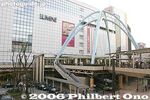
JR Tachikawa Station
|
|

Cherry tree forest near the Nishi-guchi (west) gate.
|
|

The outdoor architectural museum is within Koganei Park in Koganei, Tokyo. This is the Visitors Center.
|
|

Ryogoku Kokugikan sumo arena as seen from Ryogoku Station
|
|

The Kokugikan as seen from JR Ryogoku Station platform.
|
|

PR poster designed by Tetsuo OshiroPoster for the race.
京都大学ボート部OBの尾城徹雄様に作成したポスター。大学内や大津市石山商店街などで張り出された。
|
|
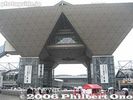
On June 6, 2004, the Athens Olympic Torch Relay came through Tokyo as it has been doing at all cities in the world which had held a Summer Olympics. Starting point: Tokyo Big SightI chased the flame for Athens at several points in Tokyo.
|
|
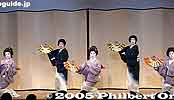
"Hana no Kai" Dance by Kagurazaka geishaThe "Hana no Kai" geisha dance is held annually by geisha in Kagurazaka, one of Tokyo's major geisha districts. "Hana" means livley or gaudy. And "Kai" can mean gathering or party.
They held two shows on the same day. This was the second show starting at 3 pm on April 16, 2005. It lasted till about 4:45 pm.
|
|
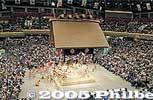
More people than the real tournamentAbout 8,000 people took time out from their Golden Week holidays to see this official sumo practice of all sumo stables.
|
|
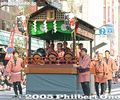
This page is a complete English guide to all the groups that appear in the parade. The parade assembles behind Sensoji Temple and starts at 1:30 pm from Nitenmon gate. The procession then goes down Umamichi-dori street, passes by Matsuya Department Store.先導 子供江戸囃子屋台
|
|
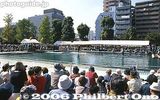
Huge crowd at Kakunori pond in Kiba Park.
|
|
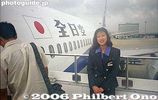
Hi Philbert! Welcome aboard!
|
|

Each dance troupe starts with a lantern bearer showing the name of the troupe.The dance is quite simple. While bobbing up and down, the dancer holds her hands above the head and shakes the fingers. This hand gesture indicates that the person has gone crazy. It is therefore nicknamed the "fool's dance." The dance is held on the last weekend in August.
|
|

Part 1 - Edo Scenes (江戸風情): 1. Fuji Murasaki (Purple Wisteria) 藤むらさきDancers: 小奴、千佳、由良子、舞子
|
|

Women at the starting line for triathlon
|
|

Tsukiji Hongwanji temple gate with wisteria crest.The emblem is a wisteria flower and symbol of the Jodo Shinshu sect.
|
|

Path to shrine
|
|
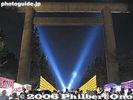
Yasukuni Shrine's main torii during Mitama Matsuri
|
|

Shrine hall
|
|

Tokyo Dome
|
|

Entrance to Hanegi Park's plum grove
|
|

Entrance to Tokyo Big Sight
|
|

Tokyo Big Sight hallway
|
|

Closest train station is Hinata-Wada Station. To get to Hinata-Wada, you have to change trains at Ome Station on the JR Chuo Line. 日向和田駅Sadly, spring 2014 was the last time we could see these trees. The plum trees were infected by the plum pox virus and the city cut down all the trees in 2014 to wipe it out. These photos were taken in 2006 when the plums were still fully glorious. Good news is that they have been replanting since 2016.
|
|
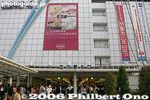
JR Tachikawa Station entrance
|
|

Koganei Park sakura
|
|

Going to visitors center
|
|

Crowd outside the Kokugikan await their favorite wrestlers.
|
|
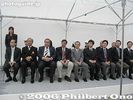
Dignitaries at the torch relay starting ceremony.
|
|

"Blue Ocean Waves" (青海波)They performed four numbers. This first one was called "Blue Ocean Waves" performed by five geisha.
|
|
|

From Matsuya Department Store, the procession turns right into Kaminarimon-dori street which passes in front of the famous, giant red lantern called Kaminarimon Gate. Lead float with Edo festival music played by children. 先導 子供江戸囃子屋台
|
|
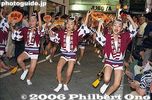
The troupe can consist of children (as young as age 2 or 3), women, and men.The Awa Odori originated 400 years ago in Tokushima Prefecture (in Shikoku) where it is one of Japan's most famous festivals. Although it is not as large as the one in Tokushima, the Koenji Awa Odori in Tokyo has become a major summer festival in Tokyo.
|
|
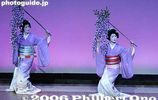
1. Fuji Murasaki (Purple Wisteria)
|
|

Temple gate and flag
|
|
|
|

Promenade to the shrine
|
|
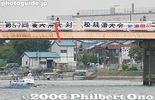
Karahashi Bridge as the starting point for alumni races
|
|

Barrels of cold water in front of shrine
|
|

Front entrance to Tokyo Dome. Japan plays its first WBC game and the opponent is China.
|
|

The plum trees are on a small hill.
|
|

Photo Imaging Expo 2006 sign
|
|

Corridor to anime fair
|
|

Although still small, the replanted plum trees have been flowering. and the groves have reopened to the public. Yoshino Baigo poster. Yoshino Baigo is a small town in Ome city near Hinata-Wada Station.
|
|
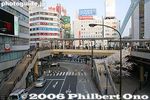
JR Tachikawa Station walkways
|
|

Huge trees shower you with cherry blossoms.
|
|

Visitors Center entrance courtyard
|
|

Crowd enters the Kokugikan for Musashimaru's retirement ceremony on Oct. 2, 2004.
|
|
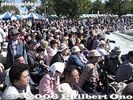
It starts at 11 am, so if you want a good view, go there early.
|
|
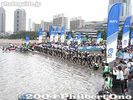
Starting line
|
|
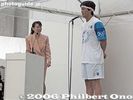
Nagashima Kazushige substitues for his father, baseball hero Nagashima Shigeo, who was hospitalized.
|
|

Notice that the kimono design shows waves.
|
|

Yokozuna Deliberation Council membersIn the middle is Kitanoumi.
|
|

Lead float with Edo festival music played by children. The names of the children playing are written on the red lanterns hanging above. Kodomo Edo-bayashi yatai 先導 子供江戸囃子屋台
|
|

The Koenji Awa Odori has become a major summer festival in Tokyo. It had a humble beginning in 1957 when it was originally called the Koenji Baka Odori. "Baka" means fool.
|
|

Kiba Sqaure Log Rolling is performed by the Kiba Kakunori Hozon-kai or Preservation Society. 木場角乗保存会
|
|

1. Fuji Murasaki (Purple Wisteria)
|
|

8:10 am: And they're off, taking about 30 min. to swim 1.5 km.
|
|

Play room for kids on Hanamatsuri
|
|

Statue of Omura Masujiro (1824-1869) 大村益次郎, founder of Japan's modern army. Also pushed for the establishment of Yasukuni Shrine.
|
|

Spotlights create a silhouette of the statue of Omura Masujiro (1824-1869) 大村益次郎, founder of Japan's modern army.
|
|

Barrels of cold water
|
|

Chinese team is introduced.
|
|

Hanegi Park has plum blossoms in mid-Feb. to early Mar. It has about 700 plum trees and also sports facilities and public library.
|
|

Hallway
|
|

PR poster
|
|

Road to Yoshino Baigo. Almost the entire town is lined with plum trees.
|
|
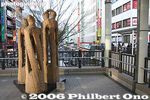
Walkway sculpture
|
|
|
|

Passing out programs
|
|
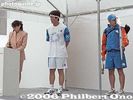
An Olympic torch attendant stands by to hand over the torch. In his right hand, he holds a small lantern housing a little flame in case the main torch is snuffed out.
|
|
|
|
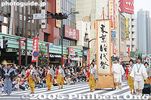
Tokyo Jidai Matsuri Banner and Tekomai geisha. From top to bottom, the banner reads, "Tokyo Jidai Matsuri." It marks the official and real start of the festival parade. The first Tokyo Jidai Matsuri was held in 1989. 東京時代祭本旗The first Tokyo Jidai Matsuri was held in 1989. Slight changes in the festival have been made since. Instead of two oiran courtesans, there is only one now. And at the end of the parade, the Asakusa Revue of showgirls used to be the anchor. But they are now gone.
東京時代祭本旗、手古舞
|
|
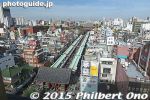
Bird's eye view of Asakusa with Kaminarimon Gate (big red lantern) and Nakamise arcade.
|
|

Kiba used to be where wood and lumber were stored and produced. 相乗り
|
|

1. Fuji Murasaki (Purple Wisteria)
|
|
|

Hanamatsuri altar
|
|
|

A bon dance around the base of the statue.
|
|

Kyoto Univ. in dark blue T-shirts
|
|

The congregation gather on the steps and beat fan-shaped drums.
|
|

Japan's National Anthem is played.
|
|
|

To PIE 2006 held in late March.
|
|

The crowds
|
|

Tamagawa River as seen from the bridge.
|
|
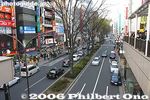
Street
|
|

One trademark of the dancers is the crescent-shaped straw hats.
|
|
|
|
|

Musashimaru at the entrance
|
|
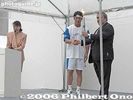
The Greek ambassador to Japan gives the torch to Kazushige.
|
|

Rear view
|
|

Sumo elders in the front row
|
|
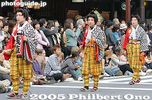
Tekomai geisha existed since the Edo Period. They served as side entertainment at festivals. They only sing traditional chant-like songs called kiyari originally sung by lumberers hauling wood. 手古舞These tekomai did not sing, so they might not be real. When they sing, they hold a fan to their mouth.
手古舞
|
|
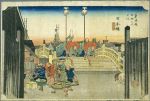
Hiroshige's woodblock print of Nihonbashi from his "Fifty-Three Stations of the Tokaido Road" series.
|
|
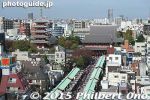
Green roofed Nakamise path to Sensoji temple in Asakusa.
|
|

Men managing the logs in the river eventually developed their own log tricks while on the job.
|
|

1. Fuji Murasaki (Purple Wisteria)
|
|
|

Pouring sweet tea over the BuddhaWhen the Buddha was born in Lumbini Garden in Nepal, sweet rain is said to have fallen. Thus, sweet tea is poured over the baby Buddha statue in the Hanamatsuri altar.
|
|

Second torii
|
|
|
|

Priests appear
|
|

Tommy Lasorda after throwing the flubbed first pitch.He just threw the ball right on the ground like he wanted to throw it away. It wasn't a pitch at all. What was his problem?
|
|
|

PIE 2006 ticket booth
|
|

Character balloons
|
|

Plum trees line the streets
|
|

Sidewalk
|
|

The men look more like the "fools."
|
|

Low branches are common
|
|

Musashimaru greets the crowd
|
|

Jisho-in Mausoleum
|
|
|

Shimada hairstyleStandard hairstyle for geisha. This a wig.
|
|

Former yokozuna Taiho, Takanosato, Kotozakura, and Wakanohana watch intently.
|
|
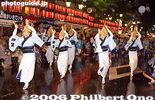
The parade route centers on JR Koenji Station. There are wide and narrow portions of the route.If it rains, they may stop the festival early.
|
|

Tekomai geisha costume is partially masculine with trousers instead of skirts. Their right shoulder is "exposed" showing a flower design. They carry a red paper lantern imprinted with their names and use their right hand to drag a wand."Asakusa" is written on her lantern. 手古舞
|
|

Eisen's woodblock print of Nihonbashi from his Kisokaido series.
|
|
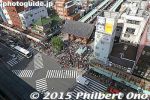
Kaminarimon Gate (big red lantern) and intersection in Asakusa.
|
|

A long bamboo pole is used for balance.
|
|
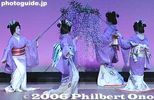
1. Fuji Murasaki (Purple Wisteria) by Kagurazaka geisha
|
|
|
|

Hanamatsuri celebrates the Buddha's birthday on April 8. This is Tsukiji Honganji in Tokyo.The flowers symbolize Lumbini Garden where the Buddha was born in present-day Nepal.
|
|

You wash your mouth hands here. Built in 1940 by Japanese living in the US. 大手水舎
|
|
|

Finish line 300 meters later
|
|

Way to Kokugikan. The guarded side gate on the right is for sumo wrestlers.
|
|
|

Crowd behind homeplate. 16,000 yen seats.
|
|
|
|

Ticket booth
|
|

Pretty CureKids could have their picture taken with these characters.
|
|

Yoshino Baigo's main attraction is the Ume no Koen plum park. This is an entrance leading to the park.
|
|

Monorail
|
|
|

Mansion of Mitsui Hachiroemon, one of the museum's must-see buildingsFounder of the Mitsui zaibatsu.
|
|

Hawaii's last sumo wrestler shakes hands.If he were married, his wife would be beside him.
|
|
|
|

Music and singing accompanimentAll numbers was accompanied by live music and singing.
|
|

Asashoryu greets the council upon entry
|
|

Tekomai geisha
|
|
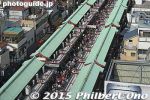
Nakamise
|
|
|

1. Fuji Murasaki (Purple Wisteria)
|
|
|

Baby Buddha statueLadles are provided for pouring the sweet tea over the Buddha. Sweet tea is also provided to worshippers. It symbolizes the sweet rain that fell when the Buddha was born.
|
|

Gate built in 1934. 神門
|
|

Tokyo Univ. (Todai) crew return to land after a race
|
|

Chuo-dori avenue looking toward Nihonbashi Bridge.
|
|

Spotlights hit the torii.
|
|

Taiko drum tower
|
|
|

China at bat.
|
|
|
|

It is most crowded along the large avenues. The crowd is several rows deep. Those in the front are expected to sit down.
|
|

Entrance hall
|
|

Kids could have their picture taken with these characters.
|
|

Ume no Koen park straight ahead, you can see the hill covered with white.
|
|
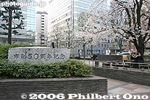
50th anniversary park
|
|
|

Inside Mitsui Hachiroemon mansion
|
|

Musashimaru right after I shook his hand.
|
|
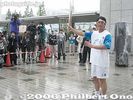
About 11 am: Here we go folks, the first of 136 runners in Tokyo.
|
|
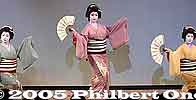
Eight Views of Tatsumi (巽八景)The second number was about the Tatsumi and Monzen-nakacho (Fukagawa) district in Koto Ward, Tokyo. The dance reflects the chic and bravado of the area (in the old days) which was one of Tokyo's gay quarters with geisha as well.
|
|

Asashoryu sips water offered by Ozeki ChiyotaikaiAs soon as Asashoryu entered the arena, many wrestlers went up to him to offer water as a show of respect.
|
|
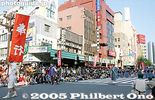
Magistrate Procession 奉行
|
|
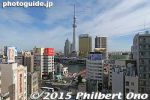
Tokyo Skytree
|
|

Head stand
|
|

1. Fuji Murasaki (Purple Wisteria)
|
|
|
|

Children dressed for the chigo parade, Tsukiji Hongwanji, TokyoIt took a long time before they could get all the kids to settle down for the picture and to get all the mothers out of the picture.
|
|

Back view of second torii
|
|
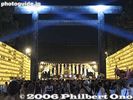
At night, 30,000 lanterns light up. A real summer spectacle.
|
|
|
|

Nihonbashi Bridge ahead, with the expressway over it.
|
|

Poster for Tokyo Marathon 2007 held on a cold, rainy day on Feb. 18, 2007.
|
|
|

Pitcher Koji Uehara, originally from the Yomiuri Giants.Unfortunately, Daisuke Matsusaka did not pitch this night.
|
|
|

Main hall on 1st floor
|
|

Digimon SaversKids could have their picture taken with these characters.
|
|

Entrance to a temple with a view
|
|

The dancers hop on one leg.So what is Tokushima's Awa Odori doing in Koenji, Tokyo? It was first organized by a youth group of Koenji's retail merchants in 1957. They wanted to hold an event to attract more shoppers to the area. Neighboring town Asagaya had already started the Tanabata Festival in 1954. The Tanabata Matsuri, of course, is from up north in Sendai, Miyagi Pref. So the Koenji folks decided to transplant a southern festival to Koenji. That was the Awa Odori.
|
|
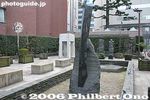
Sculptures
|
|

Taiko drum tower
|
|
|
|

Tokiwadai Photo Studio, 1937Unfortunately, it was closed for renovations. It has a large frosted glass which brought in daylight for studio lighting.
|
|

Signboard for retirement ceremony at entrance.It reads "Musashimaru, Intai Danpatsu Hiroo Ozumo" which means "Musashimaru Topknot-Cutting and Retirement Sumo Exhibition."
|
|

Omi Fair video taken on March 2, 2014 at Takashimaya Dept. Store in Nihonbashi, Tokyo. Funazushi, Omi beef, Biwa pearls, and more. We also saw Hiko-nyan.
|
|
|
|
|
|

Asashoryu and TochiazumaAfter offering water, Tochiazuma shares a laugh with the yokozuna.
|
|

About the Tokyo Motor Show...Makuhari Messe is near Kaihin Makuhari Station on the Keiyo and Musashino Lines. The huge show occupies the entire Makuhari Messe consisting of the North, East, Center, and West Halls, and Event Hall. Admission was 1200 yen. The show sees over 1.4 million visitors.
Although this is called the 39th Tokyo Motor Show in 2005, the first motor show was held in 1954 and called the 1st All-Japan Motor Show. The venue was Hibiya Park in Tokyo. In 1964, the show was renamed "Tokyo Motor Show." The show was held annually until 1973 when the oil shock occurred. It was so severe that organizers decided to hold the show every other year. No show was held in 1974. From 1975, the show was held every other year. 2005 is actually the 50th anniversary of the motor show.
In 1958, the venue changed to Korakuen Bicycle Racing Stadium. Also in 1958, the date was changed from spring (April-May) to fall (Oct.-Nov). In 1959, the venue was switched to Harumi at the domed Tokyo International Trade Center where it would remain until 1987 when it moved to Makuhari Messe in 1989. In 1970, foreign automakers participated in the Tokyo Motor Show for the first time.
In 1999, the show combined passenger cars and motorcycles. Also, in 1999, the show for commercial vehicles was omitted and instead to be held in a separate show in alternating years starting in 2000. The motor show for passenger cars and motorcycles would continue to be held every two years from 1999. So there would be a Tokyo Motor Show every year, but the purpose would alternate between passenger cars/motorcycles and commercial vehicles.
During the 1st motor show in 1954, when most of the vehicles displayed were for commercial use, the attendance was 547,000. In 1963, it exceed 1 million over 16 days. It hovered around 1.4 million in the years following. The record attendance was attained in 1991 with over 2 million visitors during 15 days. In 2003, the total attendance was 1.424 million.
In 2000, at the first Tokyo Motor Show dedicated to commercial vehicles, attendance was a mere 177,900 over 5 days. In 2004, attendance was 248,600 over 6 days.
The ubiquitous female companions, attendants, or models that we see today started appearing at the show from as early as 1957. They do not only decorate the show, but they also reflect the fashion of the times. Their hairstyles, wardrobe, skirt length, make-up, etc. The Tokyo Motor Show is not only a showcase for cars, it is also a fashion showcase. Therefore, in this online photo gallery, you will see not only cars, but also women. Enjoy!
|
|
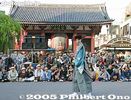
A magistrate (bugyo) in Edo could be a regional governor or government minister.
|
|
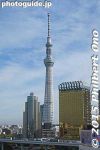
Tokyo Skytree
|
|
|

1. Fuji Murasaki (Purple Wisteria)
|
|
|

Children dressed for the chigo parade (photo session), Tsukiji Hongwanji, Tokyo
|
|

Tokyo and the Kanto region's largest tulip field attains full bloom every mid-April. The Tulip Matsuri Festival is held for about 10 days, covering two weekends. It comes on the heels of Hamura's Sakura Matsuri held in early April along the Tamagawa River. On the weekend, free shuttle buses from Hamura Station take you to the tulip field. Closest station is Hamura Station (East Entrance) on the JR Ome Line. 羽村駅
|
|
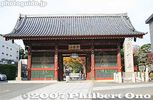
Belonging to the Buzan School of the Shingon Sect of Buddhism, Gokokuji Temple was built by the mother of Shogun Tokugawa Tsunayoshi in 1682. The Gekkoden Hall was moved here from Miidera temple in Otsu, Shiga Pref. The Tahoto Pagoda was modeled after the Tahoto at Ishiyamadera in Otsu, Shiga. Okuma Shigenobu, founder of Waseda Univ., is also buried here. This is the entrance to Gokokuji Temple, Niomon Gate. It's right next to Gokokuji Station on the Yurakucho subway line. 仁王門
|
|

Imperial crest on gate door
|
|

Senryuji Temple, Sanmon Gate, which is the front gate. Reconstructed in 1859, and renovated in 2006-2007. The temple was founded by a monk named Roben 良弁 in 765. 山門
|
|

Entrance to Kyu-Shiba Rikyu Gardens, a real oasis in an urban jungle. Another waterfront garden with classic Japanese-style elements with a pond, pine trees, rocks, and stone lanterns.
|
|

The 25th Asakusa Yabusame horseback archery was held on April 21, 2007 at Sumida Park.
|
|

Seibu Ikebukuro Line train station entrance at Ikebukuro, Tokyo. It takes about 90 min. from Ikebukuro to Yokoze Station via Tokkyu express train. Cheaper trains take 2 hours.
|
|
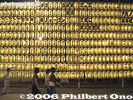
The lanterns are lit by lightbulbs, not candles.
|
|

Weeping cherry and Senzoku-Ike Pond. Near Senzoku-Ike Station on the Tokyu Ikegami Line from Gotanda.
|
|

Tokyo Shiga Kenjinkai New Year's Party 2007 平成19年 東京滋賀県人会 新年賀詞交歓会Party fee was 7,000 yen.
|
|
|

Way to Takashimaya Dept. Store in Nihonbashi subway station.
|
|

Takahata Fudo Station, Keio Line 高幡不動駅
|
|

Several groups perform along the main road on the east side of JR Shinjuku Station. This is in front of Isetan Dept. Store.
|
|

People coming to Takahata Fudoson temple on Feb. 3, Setsubun day.
|
|

Way to Mogusaen Garden
|
|

JR Okutama Station 奥多摩駅
|
|
| 18133 files on 72 page(s) |
1 |
 |
 |
 |
 |
|